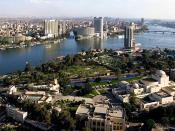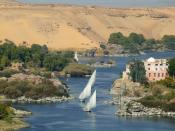Ancient Egypt was located in a critical location that resulted in the healthy development and growth of nearby countries and regions. Egypt's premier location along side the Nile River allowed for easy travel, communication and technological development, but with it came great responsibility and power from the surrounding regions.
The relationship of ancient Egypt and Africa was an extremely important one. It is clear that Egypt was the largest of all early African societies, but it was not the only one to develop agricultural technologies or early forms of government. It was the trade along the Nile that allowed for the spread of communication, technology, and goods across the African countries. The most important of these trading partners was Nubia. Nubia was the gateway to trading with other sub-Saharan societies [ Bentley 62 ].
Nubia is located in today's southern Egypt and northern Sudan. This land has one of the harshest climates in the world.
The temperatures are high throughout most of the year, and rainfall is infrequent. The banks of the Nile are narrow in much of Nubia, making farming difficult. Yet, in antiquity, Nubia was a land of great natural wealth, of gold mines, ebony, ivory and incense, which was always prized by her neighbors. Nubia is the homeland of Africa's earliest black culture with a history, which can be traced from 3100 B.C. onward through Nubian monuments and artifacts, as well as written records from Egypt and Rome.
Unlike Egypt and it's great agricultural conditions alongside the Nile that allowed it to build a very large and powerful country, Nubia wasn't as blessed with such great conditions and suffered from lack of food to stay in competition with Egypt. Nubia had to become reliant on trading of expensive and rare commodities and goods in exchange for foods.


